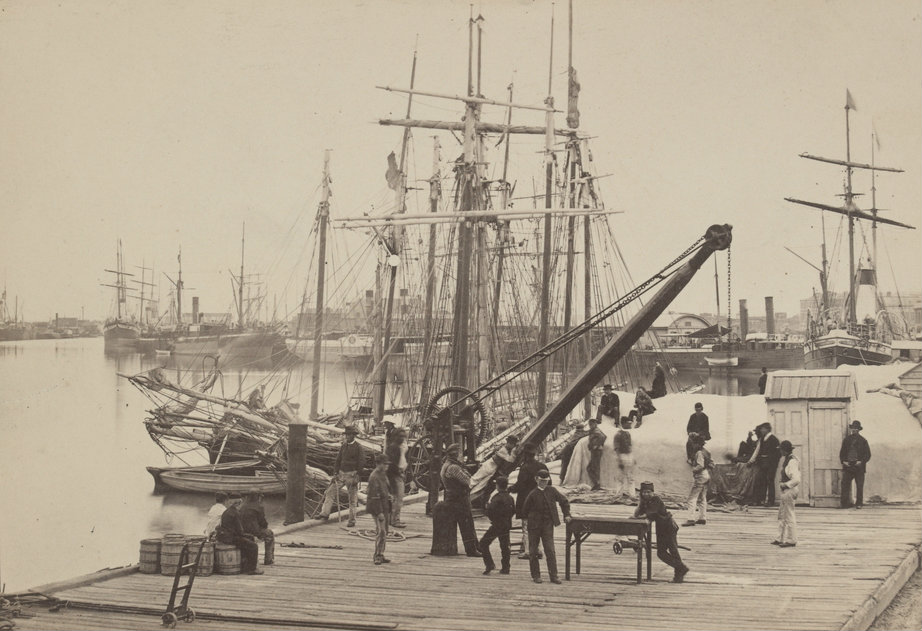Queens Wharf, Melbourne, West End, in the “Fifties“, H8819
In the late 1830s, Melbourne’s wharves consisted of logs in bogs with ships tied to posts. The area where the current Flinders and William Streets meet was surrounded by swamps and mud and when the Yarra flooded it would cover the makeshift wharves. These primitive conditions meant that boats would be tied to trees. ‘Melbourne’s import-export trade grew rapidly in the first few years of settlement, but public facilities to handle the goods did not….Goods were manhandled ashore across swaying planks, and loaded into waiting drays.’ [1]
In the early 1840s a few private wharves were built on the north side of the Yarra, the first in 1841 by Captain George Ward Cole, who carved out an open space on the banks from thick tee-tree [2]
Queen’s wharf; H91.325/1864
But the growing demand and need for a public wharf saw Queen’s wharf completed in 1842 at a cost of £80,000, built using bluestone foundations and heavy vertical timber supports. [3] ‘Cole’s and Dobson’s wharves were taken over, and eventually the new waterfront stretched from Queen’s Bridge to Spencer St. [4] Thus Queen’s Wharf became the principle place of landing goods at the Port of Melbourne.
Queen’s Wharf, Melbourne, H2429
The Yarra was a very busy port which made it difficult for a large ship to manoeuvre under such crowded conditions. ‘Many ships remained anchored off the mouth of the Yarra in Hobson’s Bay, and passengers either came upstream in a small boat, or travelled overland from Sandridge’ (modern day Port Melbourne). [5] Indeed, according to one source, ‘the traffic of these times was so heavy that it was impossible for a driver to recover a box of gold that had been dropped overboard from a small steamer. [6]
So who knows, maybe there’s still a box of gold at the bottom of the Yarra?
[Queen’s Wharf], H96.74
Bibliography
[1] Cannon, M, 1991, Old Melbourne town before the gold rush, Main Ridge, Vic. : Loch Haven Books, p. 380
[2] Newnham , W.H., Melbourne, biography of a city, Melbourne, Hill of Content, p. 147
[3] Cannon, M, 1993, Melbourne after the gold rush, Main Ridge, Vic. Loch Haven Books, p. 31
[4] Newnham, W.H., Melbourne, biography of a city, Melbourne, Hill of Content, p. 147
[5] Lewis, M; Melbourne : the city’s history and development / Miles Lewis for the City of Melbourne, p. 36
[6] Newnham , W.H., Melbourne, biography of a city, Melbourne, Hill of Content, p. 147






Hi Paul, great article! I found this resource when Googling Queen ‘s Wharf after reading about it in Hell Ship by Michael Veitch.
That’s a vivid description of Melbourne’s very early port facilities. In the late 1830s, the settlement was growing quickly, but the infrastructure lagged far behind the pace of trade.